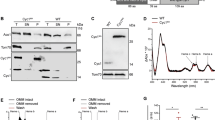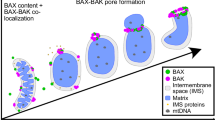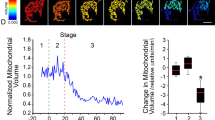Abstract
Mitochondria trigger apoptosis by releasing caspase activators, including cytochrome c (cytC). Here we show, using a pH-sensitive green fluorescent protein (GFP), that mitochondria-dependent apoptotic stimuli (such as Bax, staurosporine and ultraviolet irradiation) induce rapid, Bcl-2-inhibitable mitochondrial alkalinization and cytosol acidification, followed by cytC release, caspase activation and mitochondrial swelling and depolarization. These events are not induced by mitochondria-independent apoptotic stimuli, such as Fas. Activation of cytosolic caspases by cytC in vitro is minimal at neutral pH, but maximal at acidic pH, indicating that mitochondria-induced acidification of the cytosol may be important for caspase activation; this finding is supported by results obtained from cells using protonophores. Cytosol acidification and cytC release are suppressed by oligomycin, a FoF1-ATPase/H+-pump inhibitor, but not by caspase inhibitors. Ectopic expression of Bax in wild-type, but not FoF1/H+-pump-deficient, yeast cells similarly results in mitochondrial matrix alkalinization, cytosol acidification and cell death. These findings indicate that mitochondria-mediated alteration of intracellular pH may be an early event that regulates caspase activation in the mitochondrial pathway for apoptosis.
This is a preview of subscription content, access via your institution
Access options
Subscribe to this journal
Receive 12 print issues and online access
$209.00 per year
only $17.42 per issue
Buy this article
- Purchase on Springer Link
- Instant access to full article PDF
Prices may be subject to local taxes which are calculated during checkout







Similar content being viewed by others
References
Li, P. et al. Cytochrome c and dATP-dependent formation of Apaf-1/Caspase-9 complex initiates an apoptotic protease cascade. Cell 91, 479–489 (1997).
Green, D. R. & Reed, J. C. Mitochondria and apoptosis. Science 281, 1309–1312 ( 1998).
Reed, J. C. Cytochrome c: can’t live with it; can’t live without it . Cell 91, 559–562 (1997).
Susin, S., Zamzami, N. & Kroemer, G. Mitochondria as regulators of apoptosis: doubt no more . Biochim. Biophys. Acta. 1366, 151– 165 (1998).
Bernardi, P. et al. The mitochondrial permeability transition. Biofactors 8, 273–281 ( 1998).
Van der Heiden, M. G. & Thompson, C. B. Bcl-2 proteins: regulators of apoptosis or of mitochondrial homeostasis? Nature Cell Biol. 1, E209–E216 (1999).
Llopis, J., McCaffery, J. M., Miyawaki, A., Farquhar, M. G. & Tsien, R. Y. Measurement of cytosolic, mitochondrial and Golgi pH in single living cells with green fluorescent proteins. Proc. Natl Acad. Sci. USA 95, 6803– 6808 (1998).
Petronilli, V. et al. Imaging the mitochondrial permeability transition pore in intact cells. Biofactors 8, 263– 272 (1998).
Nicholls, D. G. & Ward, M. W. Mitochondrial membrane potential and neuronal glutamate excitotoxicity: mortality and millivolts . Trends Neurosci. 23, 166– 174 (2000).
Wachter, R. M., Elsliger, M. A., Kalliio, K., Hanson, G. T. & Remington, S. J. Structural basis of spectral shifts in the yellow-emission variants of green fluorescent protein. Structure 6, 1267–1277 ( 1998).
Alberts, B. et al. Molecular Biology of The Cell Vol. 1, Ch. 14 (Garland, New York & London, 1994).
Bossy-Wetzel, E., Newmeyer, D. & Green, D. Mitochondrial cytochrome c release in apoptosis occurs upstream of DEVD-specific caspase activation and independently of mitochondrial transmembrane depolarization. EMBO J. 17, 37–49 (1998).
Macho, A. et al. Glutathione depletion is an early and calcium elevation is a late event of thymocyte apoptosis. J. Immunol. 158, 4612–4619 (1997).
Suzuki, Y., Ono, Y. & Hirabayashi, Y. Rapid and specific reactive oxygen species generation via NADPH oxidase activation during fas-mediated apoptosis. FEBS Lett. 425, 209–212 ( 1998).
Gottlieb, R., Nordberg, J., Skowronski, E. & Babior, B. Apoptosis induced in Jurkat cells by agents is preceded by intracellular acidification . Proc. Natl Acad. Sci. USA 93, 654– 658 (1996).
Kluck, R. M., Bossy-Wetzel, E., Green, D. R. & Newmeyer, D. D. The release of cytochrome c from mitochondria: a primary site for Bcl-2 regulation of apoptosis. Science 275, 1132 –1136 (1997).
Yang, J. et al. Prevention of apoptosis by Bcl-2: release of cytochrome c from mitochondria blocked. Science 275, 1129–1132 (1997).
Matsuyama, S., Xu, Q., Velours, J. & Reed, J. C. Mitochondrial F0F1-ATPase proton-pump is required for function of pro-apoptotic protein bax in yeast and mammalian cells. Mol. Cell 1, 327–336 ( 1998).
Nicholls, D. & Budd, S. Mitochondria and neuronal survival . Physiol. Rev. 80, 315– 360 (2000).
Leist, M., Single, B., Castoldi, A. F., Kuhnle, S. & Nicotera, P. Intracellular adenosine triphosphate (ATP) concentration: a switch in the decision between apoptosis and necrosis . J. Exp. Med. 185, 1481– 1486 (1997).
van Raaij, M. J., Abrahams, J. P., Leslie, A. G. W. & Walker, J. E. The structure of bovine F 1-ATPase complexed with the antibiotic inhibitor aurovertin B. Proc. Natl Acad. Sci. USA 93, 6913–6917 (1996).
Eguchi, Y., Srinivasan, A., Tomaselli, K. J., Shimizu, S. & Tsujimoto, Y. ATP-dependent steps in apoptotic signal transduction. Cancer Res. 59, 2174 –2181 (1997).
Martin, S. J. et al. Cell-free reconstitution of Fas-, UV radiation- and ceramide-induced apoptosis. EMBO J. 14, 5191– 5200 (1995).
Gross, A., McDonnell, J. & Korsmeyer, S. BCL-2 family members and the mitochondria in apoptosis . Genes Dev. 13, 1899–1911 (1999).
Xiang, J., Chao, D. T. & Korsmeyer, S. J. BAX-induced cell death may not require interleukin 1β-converting enzyme-like proteases. Proc. Natl Acad. Sci. USA 93, 14559–14563 ( 1996).
Arato-Oshima, T., Matsui, H., Wakizaka, A. & Homareda, H. Mechanism responsible for oligomycin-induced occlusion of Na+ within Na/K-ATPase . J. Biol. Chem. 271, 25604– 25610 (1996).
Manon, S., Chaudhuri, B. & Buérin, M. Release of cytochrome c and decrease of cytochrome c oxidase in Bax-expressing yeast cells, and prevention of these effects by coexpression of Bcl-XL. FEBS Lett. 415, 29–32 (1997).
Minn, J. et al. BcI-xL regulates apoptosis by heterodimerization-dependent and -independent mechanisms. EMBO J. 18, 632–643 (1999).
Bernardi, P., Broekemeier, K. M. & Pfeiffer, D. R. Recent progress on regulation of the mitochondrial permeability transition pore; a cyclosporin-sensitive pore in the inner mitochondrial membrane. J. Bioenerg. Biomembr. 26, 509 –517 (1994).
Vaux, D. & Korsmeyer, S. Cell death in development. Cell 96, 245–254 ( 1999).
Ashkenazi, A. & Dixit, V. Death receptors: signaling and modulation . Science 281, 1305–1308 (1998).
Lemasters, J., DiGuiseppi, J., Nieminen, A. & Herman, B. Blebbing, free Ca2+and mitochondrial membrane potential preceding cell death in hepatocytes. Nature 325, 78 –81 (1987).
Chen, Q., Takeyama, N., Brady, G., Watson, A. J. M. & Dive, C. Blood cells with reduced mitochondrial membrane potential and cytosolic cytochrome c can survive and maintain clonogenicity given appropriate signals to suppress apoptosis. Blood 92 , 4545–4553 (1998).
Martinou, I. et al. The release of cytochrome c from mitochondria during apoptosis of NGF-deprived sympathetic neurons is a reversible event. J. Cell Biol. 144, 883–889 (1999).
Rajotte, D., Haddad, P., Haman, A., Cragoe Jr., E. & Hoang, T. Role of protein kinase C and the Na+/H+ antiporter in suppression of apoptosis by granulocyte macrophage colony-stimulating factor and interleukin-3. J. Biol. Chem. 267, 9980 –9987 (1992).
Deshmukh, M. & Johnson, J. E. Evidence of a novel event during neuronal death: development of competence-to-die in response to cytoplasmic cytochrome c. Neuron 21, 695– 705 (1998).
Rosse, T. et al. Bcl-2 prolongs cell survival after Bax-induced release of cytochrome c [see comments]. Nature 391, 496– 499 (1998).
Zhivotovsky, B., Orrenius, S., Brustugun, O. T. & Doskeland, S. O. Injected cytochrome c induces apoptosis. Nature 391, 449–450 (1998).
Khaled, A. R., Kim, K., Hofmeister, R., Muegge, K. & Durum, S. K. Withdrawal of IL-7 induces Bax translocation from cytosol to mitochondria through a rise in intracellular pH. Proc. Natl Acad. Sci. USA 96, 14476–14481 (1999).
Pérez-Sala, D., Collado-Escobar, D. & Mollinedo, F. Intracellular alkalinization suppresses Lovastatin-induced apoptosis in HL-60 cells through the inactivation of a pH-dependent endonuclease. J. Biol. Chem. 270, 6235–6242 (1995).
Thangaraju, M. et al. Regulation of acidification and apoptosis by SHP-1 and Bcl-2 . J. Biol. Chem. 274, 29549– 29557 (1999).
Thangaraju, M., Sharma, K., Liu, D., Shen, S-H. & Srikant, C. B. Interdependent regulation of intracellular acidification and SHP-1 in apoptosis . Cancer Res. 59, 1649– 1654 (1999).
Marzo, I. et al. The pro-apoptotic protein Bax and the adenine nucleotide translocator cooperate in the control of mitochondrial membrane permeability and apoptosis . Science 281, 2027–2031 (1998).
Matsuyama, S., Schendel, S., Xie, Z. & Reed, J. Cytoprotection by Bcl-2 requires the pore-forming α5 and α6 helices. J. Biol. Chem. 273, 30995–31001 (1998).
Zha, H. et al. Structure–function comparisons of the proapoptotic protein Bax in yeast and mammalian cells. Mol. Cell. Biol. 16, 6494–6508 (1996).
Velours, J. et al. The yeast ATP synthase subunit 4: structure and function. Biochimie 71, 903–915 ( 1989).
Haworth, R. & Fliegel, L. Intracellular pH in Schizosaccharomyces pombe — comparison with Saccharomyces cerevisiae. Mol. Cell. Biochem. 124, 131–140 (1993).
Deveraux, Q. L., Takahashi, R., Salvesen, G. S. & Reed, J. C. X-linked IAP is a direct inhibitor of cell death proteases. Nature 388, 300–304 ( 1997).
Jürgensmeier, J. M. et al. Bax directly induces release of cytochrome c from isolated mitochondria. Proc. Natl Acad. Sci. USA 5, 4997– 5002 (1998).
Acknowledgements
We thank G. Salvesen for helpful discussions and R. Cornell for manuscript preparation. This work was supported by grants from the NIH (GM 60554-01; N527177), the US Department of Defense BCRP (DAMD 17-96-1-6210), DOE (DE-AC03-7GSF-0098) and the American Heart Association (9920 070Y).
Correspondence and requests for materials should be addressed to J.C.R.
Author information
Authors and Affiliations
Corresponding author
Rights and permissions
About this article
Cite this article
Matsuyama, S., Llopis, J., Deveraux, Q. et al. Changes in intramitochondrial and cytosolic pH: early events that modulate caspase activation during apoptosis. Nat Cell Biol 2, 318–325 (2000). https://doi.org/10.1038/35014006
Received:
Revised:
Accepted:
Published:
Issue Date:
DOI: https://doi.org/10.1038/35014006
This article is cited by
-
Ocean warming and acidification affect the transitional C:N:P ratio and macromolecular accumulation in the harmful raphidophyte Heterosigma akashiwo
Communications Biology (2023)
-
The V-ATPases in cancer and cell death
Cancer Gene Therapy (2022)
-
Mitophagy in carcinogenesis, drug resistance and anticancer therapeutics
Cancer Cell International (2021)
-
Glutathione peroxidase-1 regulates ASK1-dependent apoptosis via interaction with TRAF2 in RIPK3-negative cancer cells
Experimental & Molecular Medicine (2021)
-
Metabolic heterogeneity confers differences in melanoma metastatic potential
Nature (2020)



